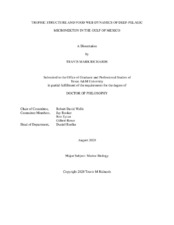Trophic Structure and Food Web Dynamics of Deep-Pelagic Micronekton in the Gulf of Mexico
Abstract
The deep-pelagic ocean is the largest but least studied ecosystem on Earth. As natural resource extraction and fisheries expand into the deep pelagic, there is increased need for comprehensive, ecosystem-based management plans for deep-pelagic ecosystems. Detailed knowledge of food webs is critical to effective ecosystem management, as trophic interactions regulate animal populations and influence the resilience of ecosystems to perturbation. Additionally, effective management strategies require data regarding feeding relationships amongst taxa, estimates of trophic position, and descriptions of energy transfer, which are lacking for the deep-pelagic Gulf of Mexico. This dissertation describes the trophic structure of deep-pelagic micronekton, which represent crucial components of deep-pelagic ecosystems worldwide, with the goal to provide data critical to the development of ecosystem-based management plans in deep-pelagic ecosystems. The first study describes fine-scale spatiotemporal variation in micronekton trophic structure in the Gulf of Mexico and presents evidence suggesting that micronekton inhabiting different regions of the water column feed within food chains supported by two different size classes of sinking particulate organic matter. The second study examines the trophic dynamics of deep-pelagic predatory fishes by providing estimates of their trophic position and quantifying their use of particulate organic matter from differing regions of the water column. Results indicate that all species occupy trophic positions between the third and fourth trophic level and receive the majority of their carbon from primary production derived near the surface of the ocean. These species, which often do not vertically migrate, access epipelagic primary production by consuming vertically migrating micronekton which forage in the epipelagic at night. The last study reveals that body size, depth of occurrence, and proximity to major oceanographic features are important determinants of trophic structure within the deep-pelagic micronekton assemblage of the Gulf of Mexico. The emerging picture of deep-pelagic food webs is one of extreme interconnectedness, with animals inhabiting the deepest depths of the GoM connected to primary production and food resources in epipelagic waters. Taken together, the results of this research increase our understanding of deep-pelagic food webs and ecosystems and will be used to better inform the construction of deep-pelagic ecosystem-based management plans.
Subject
EpipelagicMesopelagic
Bathypelagic
Gulf of Mexico
Micronekton
Stable Isotope Analysis
Food webs
Citation
Richards, Travis Mark (2020). Trophic Structure and Food Web Dynamics of Deep-Pelagic Micronekton in the Gulf of Mexico. Doctoral dissertation, Texas A&M University. Available electronically from https : / /hdl .handle .net /1969 .1 /192616.


